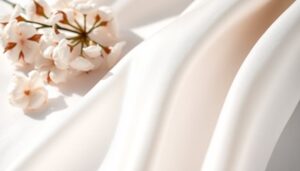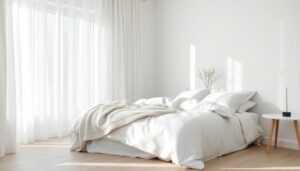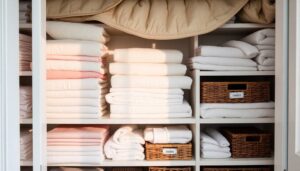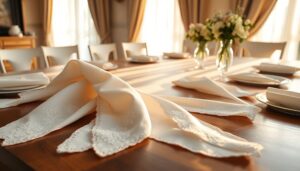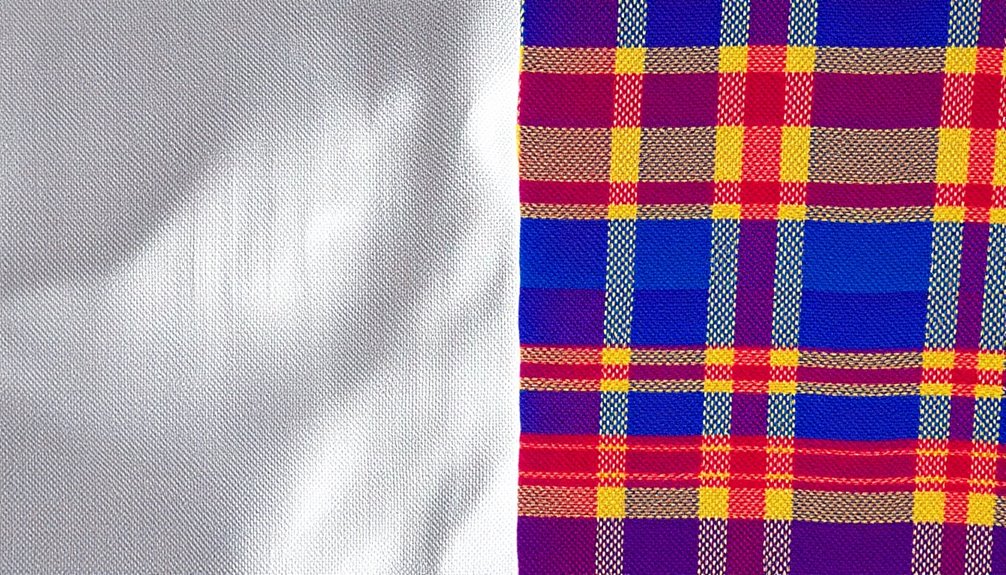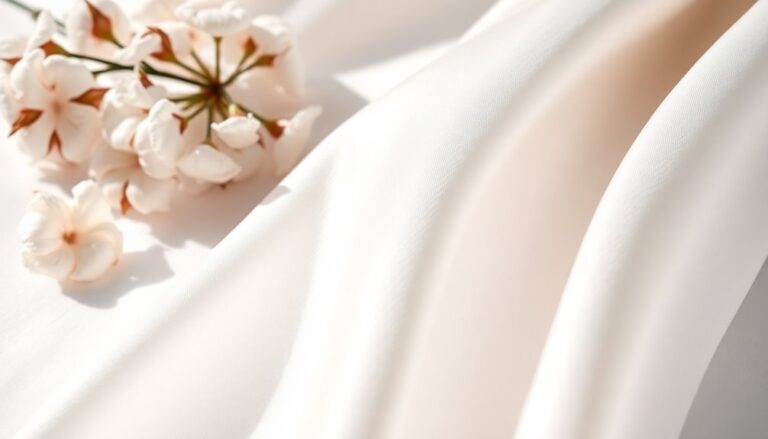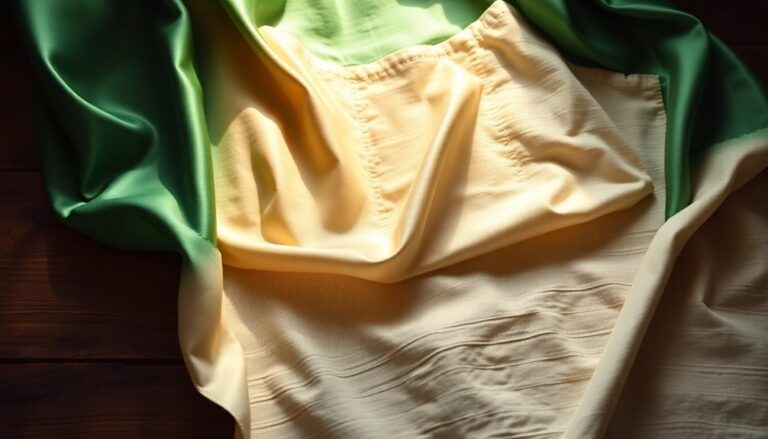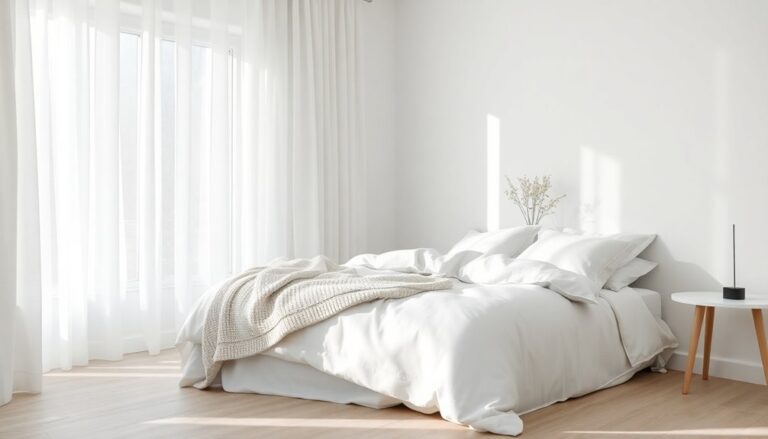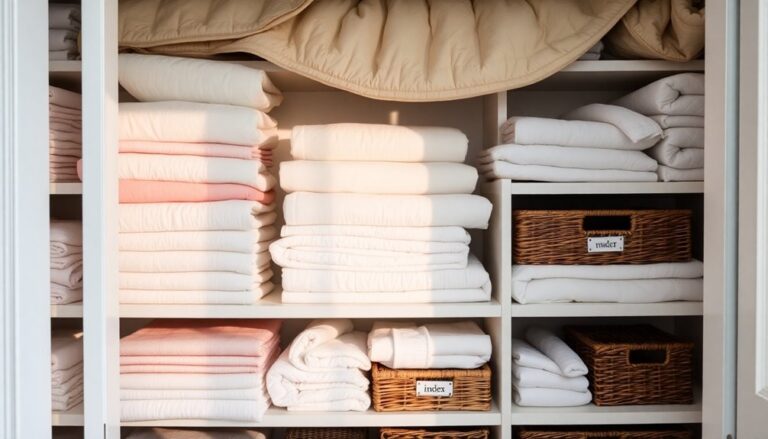Linen and madras are distinct fabrics with unique qualities. Linen, made from flax, is known for its durability and crisp texture, making it ideal for warm climates. It offers superior breathability and longevity. Conversely, madras, originating from cotton, features lively patterns and a softer feel, better suited for relaxed fashion. Although linen thrives in formal styles, madras adds a playful touch to outfits. Discovering their applications and environmental impacts provides further insight into these beloved fabrics.
Article Highlights
- Linen is made from flax, while madras is primarily crafted from lightweight cotton, influencing their textures and uses.
- Linen has a crisp, slightly rough texture, whereas madras offers a softer, more relaxed feel with vibrant patterns.
- Linen is highly durable and can last decades, while madras is less durable and may fade over time with sun exposure.
- Linen is ideal for formal and sophisticated warm-weather attire, while madras suits casual wear and adds personality to outfits.
- Linen requires less water and pesticides compared to madras, making it a more sustainable fabric option.
Overview of Linen

Linen, a timeless fabric, has been cherished for centuries due to its durability and breathability. Known for its unique linen properties, it offers a natural feel that's both soft and resilient. This fabric is highly absorbent and dries quickly, making it ideal for warm climates. Nevertheless, linen can wrinkle easily, which some people find charming as it adds character. To maintain its beauty, proper linen care is vital. Washing in cool water and avoiding bleach helps preserve its fibers. Line drying is preferred to prevent shrinkage, and ironing on a medium setting keeps it looking fresh. With the right care, linen can last for years, making it a worthwhile investment for those who appreciate quality textiles.
Overview of Madras
Madras fabric has a rich history, originating from the city of Chennai in India. Known for its lively patterns and lightweight feel, it's often used in summer apparel and home décor. The unique characteristics of Madras patterns make them a popular choice for those seeking a blend of style and comfort.
History of Madras Fabric
Originating in the 17th century, Madras fabric has a rich history that reflects both its cultural significance and practical use. Known for its lively colors and patterns, Madras has its roots in the Indian city of Chennai, formerly known as Madras. This fabric emerged as a symbol of craftsmanship, showcasing traditional weaving techniques that have been passed down through generations.
- Highly regarded for its breathability and comfort
- Initially popularized by British colonialists
- Often crafted from cotton, enhancing its versatility
- Frequently used in summer clothing and home décor
Madras craftsmanship is a reflection of the skilled artisans who create these beautiful textiles, blending cultural heritage with everyday functionality. The Madras origins continue to influence fashion and design today.
Characteristics of Madras Patterns
Known for its lively hues and distinctive checks, Madras patterns are a hallmark of the fabric's appeal. These patterns feature a combination of lively color palettes, often including bright reds, greens, blues, and yellows, creating a visually striking effect. Madras motifs, typically characterized by their plaid or striped designs, reflect a rich cultural heritage and craftsmanship.
| Motif Type | Color Palette | Common Uses |
|---|---|---|
| Plaid | Bold and bright | Casual wear |
| Striped | Pastel combinations | Summer attire |
| Checked | Earthy tones | Home decor |
| Floral | Mixed lively colors | Accessories |
| Geometric | Contrasting colors | Fashion statements |
These characteristics make Madras fabric a favorite for those seeking unique and colorful designs.
Popular Uses of Madras
With its lively patterns and lightweight texture, Madras fabric has become a popular choice across various applications. Its unique blend of vivid colors and distinctive designs makes it a favorite for those seeking style and comfort.
Madras is often used in:
- Casual shirts: Ideal for warm weather, showcasing eye-catching madras patterns.
- Summer dresses: The breezy fabric complements the bright madras colors, perfect for outdoor events.
- Home decor: Pillows and curtains featuring Madras add a fresh, cheerful touch to any room.
- Table linens: Tablecloths and napkins in madras designs create an inviting atmosphere for gatherings.
Fabric Composition
When comparing linen and madras, the fabric composition highlights key differences. Linen is primarily made from the flax plant, making it a natural fiber known for its durability and breathability. This fabric type is often sought after for its eco-friendliness and ability to regulate temperature. Conversely, madras is a lightweight cotton fabric, typically woven with lively patterns. The composition differences between these two fabrics affect not merely their appearance but as well their functionality. Meanwhile, linen offers a more structured feel, madras is known for its softness and comfort. Comprehending these fabric types is crucial for making informed choices in fashion and home textiles, ensuring one selects the right material for their specific needs.
Texture and Feel
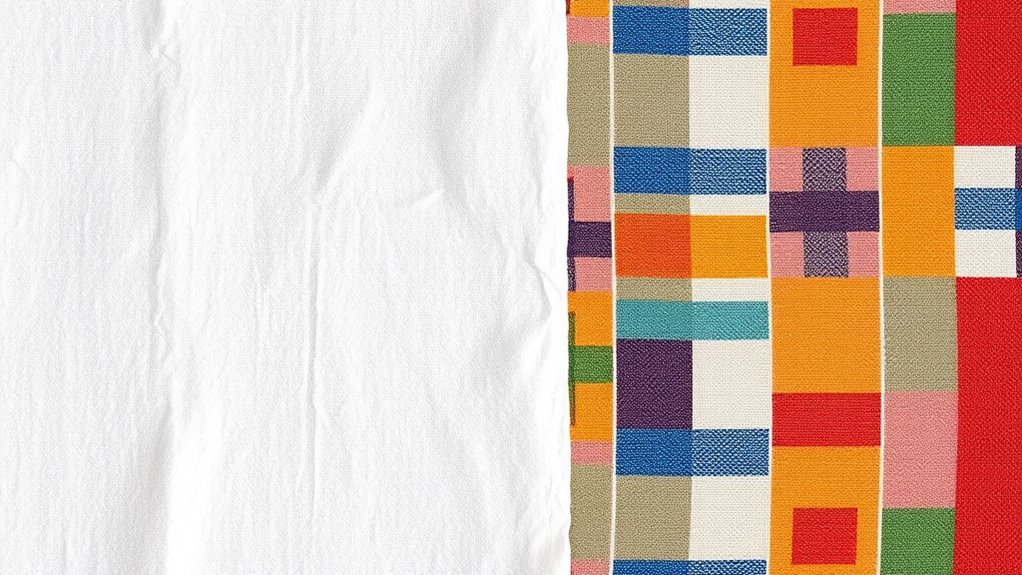
The texture and feel of linen and madras offer distinct experiences that cater to different preferences. A texture comparison reveals that linen has a crisp, slightly rough surface, giving it a luxurious and sophisticated touch. Conversely, madras provides a softer, more relaxed feel, often characterized by its lightweight and breathable nature.
When conducting a feel analysis, one might consider:
- Linen: Sturdy and textured, offering a refined aesthetic.
- Madras: Soft and smooth, embracing a casual vibe.
- Durability: Linen tends to be more resilient over time.
- Versatility: Madras is often favored for summer attire and casual settings.
Both fabrics have their unique qualities, making them suitable for different occasions and styles.
Breathability and Comfort
Although both linen and madras excel in breathability and comfort, their characteristics cater to different needs. Linen, known for its natural fibers, offers superior breathability, making it ideal for hot climates. Its moisture-wicking properties help keep the skin dry, enhancing overall comfort levels. Conversely, madras, with its lightweight cotton fabric, likewise provides decent breathability but tends to trap a bit more heat compared to linen. In a breathability comparison, linen often comes out on top, appealing to those seeking maximum comfort during warm weather. Nevertheless, madras brings a unique charm with its lively patterns, appealing to individuals who prioritize style alongside comfort. In the end, the choice depends on personal preferences regarding breathability and aesthetic appeal.
Durability and Maintenance

Breathability and comfort aren't the only factors to contemplate when choosing between linen and madras; durability and maintenance likewise play significant roles. Linen is renowned for its fabric longevity, often lasting decades with proper care. Nonetheless, it wrinkles easily, which may require more frequent ironing. Madras, in contrast, is typically less durable but offers lively patterns. It can fade over time, especially when exposed to sunlight.
Key considerations include:
- Washing: Linen can typically withstand machine washing, whereas madras may require gentler care.
- Ironing: Linen may need ironing to maintain its appearance; madras often looks best without it.
- Storing: Both fabrics benefit from cool, dry storage to prevent damage.
- Stain Treatment: Prompt treatment is essential for both fabrics to improve longevity.
Aesthetic Appeal
With regard to aesthetic appeal, both linen and madras offer distinct visual qualities that can improve any wardrobe or home decor. Linen’s natural texture provides an elegant, understated sophistication, often featuring soft, neutral tones that promote visual balance. This timeless quality makes linen versatile, allowing it to complement various color combinations effortlessly. In contrast, madras is known for its vibrant patterns and bold color schemes, adding a lively and dynamic touch to fashion and interior design. While both fabrics have their unique charm, the difference between linen and batiste lies in their texture and weight—linen is coarser and more structured, whereas batiste is lighter and smoother, offering a delicate, airy feel. This distinction makes linen ideal for durable, elegant pieces, while batiste is often preferred for delicate garments and drapery.
On the other hand, madras is known for its lively patterns and bold colors, often showcasing a spirited mix that adds a playful touch to fabrics. Its unique designs can energize a space or outfit, making it a favorite for those seeking a statement piece. In the end, the choice between linen and madras depends on personal style and the desired atmosphere, with each fabric bringing its own charm and appeal.
Common Uses in Fashion
In the domain of fashion, both linen and madras serve distinct purposes. Linen is often favored for its breathability in casual wear, making it a staple for summer outfits. Conversely, madras finds its place in formal attire, adding a lively touch to dress shirts and suits.
Casual Wear Trends
As fashion evolves, casual wear trends increasingly embrace fabrics like linen and madras for their unique qualities and versatility. These materials not only provide comfort but additionally allow for stylish casual layering, making them perfect choices for various occasions. Seasonal fabrics like linen are ideal for warm weather, whereas madras provides a lively pop of color, enhancing the overall aesthetic.
- Lightweight and breathable, perfect for summer
- Versatile patterns that can be dressed up or down
- Ideal for layering, shifting from day to night
- Suitable for both relaxed outings and casual gatherings
Incorporating these trends, fashion enthusiasts can create effortlessly chic looks that reflect personal style as well as remaining comfortable and fashionable.
Formal Attire Applications
Though many may associate linen and madras with casual wear, their unique qualities likewise make them suitable for formal attire applications. Linen's breathable fabric often lends itself to sophisticated styles, perfect for warm-weather formal events. Customized linen suits can enhance a man's wardrobe, fitting seamlessly into dress codes that demand elegance without sacrificing comfort. Conversely, madras, with its lively patterns, can add a touch of personality to formal ensembles. When used in blazers or trousers, madras can comply with smart-casual dress codes, striking a balance between tradition and modern flair. In the end, both fabrics can be creatively employed in formal settings, proving that elegance can truly coexist with comfort and style.
Home Decor Applications
While both linen and madras bring unique qualities to home decor, each fabric serves distinct purposes in enhancing interior spaces. Linen, with its elegant texture and breathable nature, complements various home decor styles, from minimalist to rustic. It's often used in upholstery, curtains, and table linens, offering a timeless appeal. Conversely, madras, known for its lively patterns and colors, adds a playful touch, making it ideal for accent pieces and throw pillows.
Consider these fabric combinations:
- Linen drapes paired with madras cushions
- Madras table runners on linen tablecloths
- Linen curtains in rooms with madras-inspired decor
- Madras quilts layered over linen bedding
These combinations create a harmonious and stylish home environment.
Environmental Impact
When comparing linen and madras, the environmental impact of each fabric becomes an essential consideration. Linen, known for its sustainability, typically requires less water and fewer pesticides than the cotton used in madras. Comprehending these factors can help consumers make more eco-friendly choices in their fabric selections.
Sustainability of Materials
As consumers increasingly prioritize sustainability, the environmental impact of materials like linen and madras has come under scrutiny. Linen, derived from the flax plant, is often celebrated for its sustainable practices and eco-friendly sourcing. Its production requires fewer pesticides and fertilizers compared to many crops. Conversely, madras fabric, typically made from cotton, can have a more significant environmental footprint because of intensive water use and chemical treatments.
Key points regarding sustainability include:
- Linen's minimal water requirements during cultivation
- Madras' reliance on conventional cotton farming practices
- The biodegradability of linen compared to synthetic alternatives
- Innovations in sustainable cotton farming aimed at improving madras' environmental impact
Understanding these differences helps consumers make informed choices about their materials.
Water Usage Comparison
Water usage is a significant factor in evaluating the environmental impact of linen and madras fabrics. Linen, made from flax, typically requires less water than cotton-based madras. Flax cultivation often involves effective water conservation practices, as it grows well in rain-fed regions. Conversely, madras, primarily produced from cotton, relies heavily on irrigation techniques in many areas, which can lead to significant water depletion. This disparity highlights the significance of sustainable farming methods. By adopting water-efficient practices, both linen and madras producers can lessen their environmental footprint. Ultimately, consumers concerned about sustainability should consider the water usage associated with these fabrics, as it plays a vital role in their overall environmental impact.
Pesticide Impact Analysis
Although both linen and madras fabrics have unique environmental impacts, the use of pesticides in their production greatly influences their sustainability. Linen, typically made from flax, often uses fewer pesticides than madras, which is usually crafted from cotton. Cotton farming can lead to significant pesticide residues, affecting soil health and surrounding ecosystems. Conversely, organic alternatives for both fabrics are gaining popularity, promoting sustainable practices and reducing harmful chemical usage.
- Linen often requires less pesticide use.
- Madras, primarily cotton-based, may have higher pesticide residues.
- Organic linen and madras options are available.
- Sustainable farming practices can mitigate environmental impacts.
Choosing fabrics with lower pesticide footprints supports a healthier planet.
Frequently Asked Questions
Can Linen and Madras Be Mixed in Clothing?
In the lively fabric of fashion, mixing linen and Madras can create a harmonious blend. Linen blends effortlessly with Madras patterns, offering a revitalizing take on style. Together, they dance between casual and chic, providing comfort and flair. When paired thoughtfully, these fabrics can enhance any outfit, infusing it with texture and personality. So, for those enthusiastic to experiment, combining linen's breathability with Madras's spirited prints can lead to stunning results.
How Do I Care for Madras Fabric?
When caring for madras fabric, it's important to use gentle washing techniques. Hand washing or a delicate cycle with cold water is recommended to preserve its lively colors. Avoid bleach, as it can damage the fabric. After washing, air drying is best to prevent shrinking. For fabric storage, keep madras items in a cool, dry place, away from direct sunlight to maintain their appearance. With proper care, madras can last for years.
Are Linen and Madras Suitable for All Seasons?
When considering if linen and madras are suitable for all seasons, one must note their seasonal versatility and climate adaptability. Linen's breathable nature makes it ideal for warmer months, whereas its insulating properties can provide comfort in cooler weather. Madras, with its lightweight design, is perfect for summer but may not offer the same warmth in winter. Both fabrics can be versatile, but their effectiveness varies depending on specific climate conditions.
Which Fabric Is More Expensive, Linen or Madras?
When considering a cost comparison between fabrics, linen typically comes out as the more expensive option. This is largely because of its high-quality production process and durability. Madras, conversely, is often more affordable, as it's produced using simpler techniques. Although both fabrics have their own unique qualities, those seeking a luxurious feel might prefer linen, even though it means investing more financially.
How Can I Identify Genuine Linen and Madras?
To identify genuine linen and madras, one can start with a texture comparison. Linen's texture is crisp and slightly rough, whereas madras feels softer and more breathable. Fabric characteristics likewise play a role; linen has a natural sheen and wrinkles easily, whereas madras is often lively with patterns and holds its shape better. Checking for labels and examining the weave can further help in distinguishing between these two distinct fabrics.

